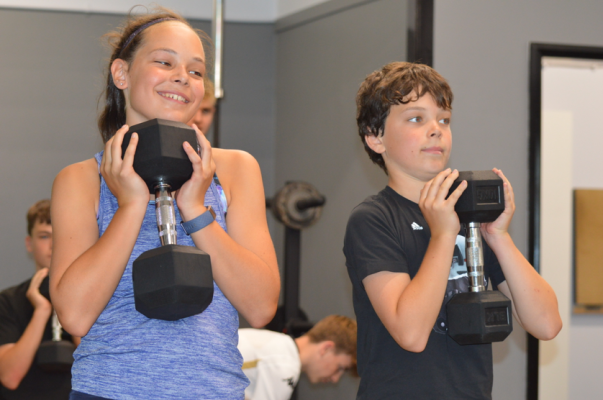This article will investigate and explore bodyweight (BW) training as a strength protocol for young elite athletes and provide evidence based, practical recommendations for young athletes starting a youth strength and conditioning (YS&C) programme in conjunction with a long-term athletic development (LTAD) framework.
Firstly, this article is not about health or the health-related benefits of BW or any other exercise type. There is a plethora of journals, articles and television shows about health and wellbeing and the importance of physical activity, yet we still live in a country in which one in ten children are struggling with obesity and on every other street corner and every third television advertisement break, there is an advert for sugary drinks or fast food, a world in which we know that sugar causes a host of metabolic disease, yet we continue to purchase sugar laden products en masse. Therefore, while the health of our youth population is highly important, and requires immediate action, unfortunately from an overweight and obesity point of view, that ship has sailed.
This article is purely aimed at the development of young, aspiring athletes who regularly attend sport training and compete against their peers. Clarification of the audience is important, as it provides a rationale for the application of the principles of strength and conditioning (S&C) along with the prescription of strength training to elite young athletic populations.
The literature strongly suggests that strength training exercises should be chosen based on the amount of stimulus provided (Aagaard et al., 2002, Young, 2006) and, in turn, the effect it will have on an individual. However, issues can arise when one starts to categorise exercises and drills, including BW training, as progressions or regressions along a continuum for strength development or as a prerequisite, for example, start with BW training then move onto loaded exercises, especially when considering training as a preparation or even transfer to sports performance.
Performance in sport is often unstable and, as such, a transfer of training effect into performance is big ask, therefore, the main aim of an S&C coach is to understand their athletes’ individual requirements and the demands of the sport via an in depth needs analysis, and subsequently, facilitate phases of training in an environment which stimulates adaptations, in order for the athlete to cope with the sporting demands (Bangsbo, 1994, Bishop et al., 2015, Lesinski et al., 2016)
Unfortunately, most youth athletes do not prepare adequately for their chosen sport prior to participation (Faigenbaum et al., 2009, Lloyd et al., 2012), rather the sport practice comes first, with the S&C training following later (sometimes years later). Whilst this is not ideal, it is the situation that most S&C coaches find themselves in and most understand their place in the grand scheme. Subsequently, having followed this path the athlete has experienced a high level of stimulation via regular bouts of sprinting, jumping and high-speed change of direction (Balyi, 2001, Ford et al., 2011, Keiner et al., 2013), thus playing the sport has presented mechanical loading upon the athlete, prior to embarking on an S&C programme. As the principle of progressive overload is seen as essential to drive strength adaptations (Hellebrandt, 1958) and thus should form part of every S&C programme, would BW squats offer an overload response to an athlete that has 5 years’ experience of rugby? To amplify this point, an athlete’s warm up consists of a number of BW exercises (Bishop, 2003, Jeffreys, 2017) providing a low-level stimulus in preparation for the increased demand of the training session, without producing excessive amounts of fatigue. Therefore, if BW training is appropriate for the warmup, should it be included in the training session i.e., does it provide enough of a stimulus to drive a strength adaptation when it is of a lesser stimulus to sport?
Bodyweight training is also often used as a precursor to loaded training for a number of reasons including safety and ease of use, due to the lack of infrastructure within the UK, with the commercial gyms and health clubs still following the narrative that weight training is for children of 16 years and over, or the outdated, biased sport coaches that believe the child will acquire the requisite strength, power, speed etc. from playing the sport and running through a few hoops, ladders and hurdles in training.
The literature states that training induces strength improvement in children as young as six, as long as they are coachable (Stratton et al., 2004, Faigenbaum et al., 2009, Lloyd et al. 2012, Wilson et al., 2017), with strength training a priority for both young male and females as it forms the foundation of many other physical attributes such as speed, power and endurance, whilst aiding development of essential sport skills and assisting with injury reduction (Faigenbaum et al., 2009, Lloyd et al. 2012, Comfort et al., 2014, Case et al., 2020).
In S&C the term intensity is used interchangeably, for example when we speak of intensity within strength training (Andersen et al., 2018), this can be absolute strength, based on a one repetition maximum (1RM) with daily fluctuations, or alternatively relative strength (amount lifted as a percentage of an athlete’s bodyweight) and also power (work done). Conversely, in conditioning training intensity is prescribed based on a projection of the internal load placed on the athlete, often using physiological measures such as heart rate, percentage of O2max and lactate threshold (Seiler, 2010, Buchheit et al., 2012) and for plyometrics it’s usually the velocity of the movement (Jensen & Ebben, 2007, Sugisaki et al., 2013); although difficult to quantify without a force plate. However, when we view BW training, intensity is difficult to quantify, other than with EMG which doesn’t account for skill level.
Further compounding this issue, Lloyd et al. (2012) state that “it would seem futile to assess ‘squat strength’ with any extra barbell resistance in a young athlete who does not possess adequate neuromuscular control in an unloaded version of the exercise”. Unfortunately, simply observing movement does not quantify a neuromuscular response, as the level of control will be specific to that particular task and environment. Thus, whilst caution is certainly required when selecting the starting load, if loading an exercise changes the training outcome (training load), and the organism self-organises based on the task and environment (Newell, 2012), what reason is there to use a BW squat to prepare the body for a loaded squat? Especially if children can experience ground reaction forces (GRF) of up to 4 x BW when jumping and sprinting (Seegmiller & McCaw, 2003, Thomas et al., 2017, Colyer et al., 2020). Furthermore, whilst maximum lifts should not be incorporated into an athlete’s programme until they are highly skilled (Faigenbaum et al., 2012), is an assessment of strength without external load a true reflection of an athlete’s strength?
The Australian strength and conditioning association (ASCA) go one step further than this in their position statement on youth S&C (Wilson et al., 2017), stating that supervised resistance training is safe for six years and above, along with all the aforementioned benefits, plus providing overviews of studies that support the use of strength training protocols including fixed machines and free weights (Falk et al.,1996, Faigenbaum et al.2003). Yet, in the next breath, still promote ‘body weight exercises and light resistance (brooms, bands etc.). I may have missed something but when did broom manufacturers start developing broomsticks of more than 1kg? A youth athlete would get as much stimulus from lifting a broom as taking their dinner plate into the kitchen. Furthermore, the only sport that a broomstick will adequately prepare you for is Quidditch (Rowling, 2015)
This dogmatic approach may derive from the belief that children will not get the full benefit from strength training as they are yet to reach maturation. Whilst this statement makes some sense, with studies showing a much larger increase in absolute strength levels in adolescents compared to children, mastering the fundamental lifts takes time. The earlier an athlete can start lifting, with a recent study by Case et al., (2020) specifying a back squat of 2.2 x BW for a male, and 1.6 x BW for a female, as desirable to help reduce injury. Thus, the higher level of skill development provides the athlete with a great base on which to improve further, once that ‘natural performance enhancing drug’, aka puberty (with an upsurge in growth related hormones), arrives.
Whilst injury is multifactorial, making youth athletes stronger, provides a buffer to injury and in turn allows athletes to train more often, further developing skill (Faigenbaum et al., 2009). From both personal experience and with the ever-increasing numbers of sport related injuries, it is clear that elite teams are either not looking at the evidence or choosing to ignore it.
In a number of settings, BW exercises are often performed slowly in order for the coach to view the athlete’s form, based on perfecting a technical model, or to (supposedly) increase the demand on the musculoskeletal system, possibly with a view to making the exercise more challenging or to enhance motor control. This scenario is often dominated by endless internal cues by the coach such to activate your core/glutes/hamstrings.
Whilst this approach may be used effectively by a physio when rehabbing an injured athlete, although the effectiveness is argued in the literature (Shea & Wulf, 1999, Wulf et al., 2002), if we take a non-injured so-called healthy athlete, there are a number of issues presented, which unfortunately we haven’t got time in this article to discuss, however, the overriding concern is that this methodology does not form part of an athlete centred approach (De Souza et al., 2008). Additionally, a coach may increase the speed of the exercise in order to further challenge the athlete’s motor control although that soon changes to a power exercise, with power defined as the rate at which work is done.
Strength transcends all other physical qualities with the ability to produce and tolerate force an essential component of most sports. BW exercise provides less of a stimulus to the system than the high forces acting upon elite young athletes when sprinting and jumping, therefore, should be seen as a regression to these activities. Therefore, in order to prepare young athletes to cope with their sporting demands and, in turn, reduce the risk of injury, athletes as young as six years old (if they can follow instructions) can undertake loaded strength exercises in a supervised, fun environment. However, more and improved research is required to provide gold standard loading parameters as part of a robust framework for youth athlete development. Or alternatively we can just continue to do what we have always done and allow thousands of athletes to leave their sport due to injury and burnout, S&C coaches and researchers, we need to do better.
References
Aagaard, P., Simonsen, E. B., Andersen, J. L., Magnusson, P., & Dyhre-Poulsen, P. (2002). Increased rate of force development and neural drive of human skeletal muscle following resistance training. Journal of Applied Physiology, 93(4), 1318–1326.
Andersen, E., Lockie, R. G., & Dawes, J. J. (2018). Relationship of Absolute and Relative Lower-Body Strength to Predictors of Athletic Performance in Collegiate Women Soccer Players. Sports, 6(4), 106.
Bangsbo, J. (1994). Energy demands in competitive soccer. Journal of Sports Sciences, 12(sup1), S5–S12.
Balyi, I., & Hamilton, A. (2004). Long-Term Athlete Development: Trainability in children and adolescents. Windows of opportunity. Optimal trainability. National Coaching Institute British Columbia & Advanced Training and Performance Ltd.
Bishop, C., Brazier, J., Cree, J., & Turner, A. (2015). A needs analysis and testing battery for field hockey. Professional Strength and Conditioning, 36, 15–16.
Brown, L. E., & Faigenbaum, A. D. (2000). Are Plyometrics Safe For Children?: Strength and Conditioning Journal, 22(3), 45.
Case, M. J., Knudson, D. V., & Downey, D. L. (2020). Barbell Squat Relative Strength as an Identifier for Lower Extremity Injury in Collegiate Athletes. The Journal of Strength & Conditioning Research, 34(5), 1249–1253.
Colyer, S. L., Nagahara, R., Takai, Y., & Salo, A. I. T. (2020). The effect of biological maturity status on ground reaction force production during sprinting. Scandinavian Journal of Medicine & Science in Sports, 30(8), 1387–1397. https://doi.org/10.1111/sms.13680
Comfort, P., Stewart, A., Bloom, L., & Clarkson, B. (2014). Relationships Between Strength, Sprint, and Jump Performance in Well-Trained Youth Soccer Players. The Journal of Strength & Conditioning Research, 28(1), 173–177.
Douma-van Riet, D., Verschuren, O., Jelsma, D., Kruitwagen, C., Smits-Engelsman, B., & Takken, T. (2012). Reference values for the muscle power sprint test in 6- to 12-year-old children. Pediatric Physical Therapy: The Official Publication of the Section on Pediatrics of the American Physical Therapy Association, 24(4), 327–332.
Faigenbaum, A. D., Kraemer, W. J., Blimkie, C. J. R., Jeffreys, I., Micheli, L. J., Nitka, M., & Rowland, T. W. (2009). Youth Resistance Training: Updated Position Statement Paper from the National Strength and Conditioning Association. The Journal of Strength & Conditioning Research, 23, S60.
Faigenbaum, A. D., McFarland, J. E., Herman, R., Naclerio, F., Ratamess, N. A., Kang, J., & Myer, G. D. (2012). Reliability of The One Repetition-Maximum Power Clean Test In Adolescent Athletes. Journal of Strength and Conditioning Research / National Strength & Conditioning Association, 26(2), 432–437
Ferrete, C., Requena, B., Suarez-Arrones, L., & Sáez de Villarreal, E. (2013). Effect of Strength And High-Intensity Training on Jumping, Sprinting And Intermitent Endurance Performance In Prepubertal Soccer Players. Journal of Strength and Conditioning Research / National Strength & Conditioning Association.
Ford, P., De Ste Croix, M., Lloyd, R., Meyers, R., Moosavi, M., Oliver, J., Till, K., & Williams, C. (2011). The Long-Term Athlete Development model: Physiological evidence and application. Journal of Sports Sciences, 29(4), 389–402.
Gevat, C., Taskin, H., Arslan, F., Larion, A., & Stanculescu, G. (2012). The effects of 8-week speed training program on the acceleration ability and maximum speed running at 11 years athletes. Collegium Antropologicum, 36(3), 951–958.
Harries, S. K., Lubans, D. R., & Callister, R. (2012). Resistance training to improve power and sports performance in adolescent athletes: A systematic review and meta-analysis. Journal of Science and Medicine in Sport, 15(6), 532–540.
Jeffreys, I. (2006). Warm up revisited – the ‘ramp’ method of optimising performance preparation. 5.
Jeffreys, I. (2017). RAMP warm-ups: More than simply short-term preparation. Professional Strength and Conditioning.
Jensen, R., & Ebben, W. (2007). Quantifying Plyometric Intensity Via Rate of Force Development, Knee Joint, and Ground Reaction Forces. Journal of Strength and Conditioning Research, 21(3), 763–767.
Keiner, M, Sander, A., Wirth, K., & Schmidtbleicher, D. (2013). Long term strength training effects on change-of-direction sprint performance. Journal of Strength and Conditioning Research / National Strength & Conditioning Association.
Keiner, Michael, Sander, A., Wirth, K., Caruso, O., Immesberger, P., & Zawieja, M. (2013). Strength performance in youth: Trainability of adolescents and children in the back and front squats. Journal of Strength and Conditioning Research / National Strength & Conditioning Association, 27(2), 357–362.
Lesinski, M., Prieske, O., & Granacher, U. (2016). Effects and dose–response relationships of resistance training on physical performance in youth athletes: A systematic review and meta-analysis. British Journal of Sports Medicine, 50(13), 781–795.
Lloyd, R. S., & Oliver, J. L. (2012). The Youth Physical Development Model: A New Approach to Long-Term Athletic Development. Strength and Conditioning Journal, 12.
M. Newell, K. (2012). Functions of Learning and the Acquisition of Motor Skills (With Reference to Sport). The Open Sports Sciences Journal, 5(1), 17–25.
Rowling, J. K. (1997). Harry Potter and the Philosopher’s Stone. Bloomsbury Publishing.
Seegmiller, J. G., & McCaw, S. T. (2003). Ground Reaction Forces Among Gymnasts and Recreational Athletes in Drop Landings. Journal of Athletic Training, 38(4), 311–314.
Seiler, K. S., & Kjerland, G. Ø. (2006). Quantifying training intensity distribution in elite endurance athletes: Is there evidence for an “optimal” distribution? Scandinavian Journal of Medicine & Science in Sports, 16(1), 49–56.
Shea, C. H., & Wulf, G. (1999). Enhancing motor learning through external-focus instructions and feedback. Human Movement Science, 18(4), 553–571.
Souza, A. de, & Oslin, J. (2008). A Player-Centered Approach to Coaching. Journal of Physical Education, Recreation & Dance, 79(6), 24–30.
Stratton, G., Jones, M., Fox, K., Tolfrey, K., Harris, J., Maffulli, N., Lee, M., & Frostick, S. (2004). BASES Position Statement on Guidelines for Resistance Exercise in Young People. Journal of Sports Sciences, 22(4), 383–390.
Sugisaki, N., Okada, J., & Kanehisa, H. (2013). Intensity-level assessment of lower body plyometric exercises based on mechanical output of lower limb joints. Journal of Sports Sciences, 31(8), 894–906.
Thomas, C., Comfort, P., Jones, P. A., & DosʼSantos, T. (2017). Strength and Conditioning for Netball: A Needs Analysis and Training Recommendations. Strength and Conditioning Journal, 39(4), 10–21.
Wulf, G., Mcconnel, N., Gärtner, M., & Schwarz, A. (2002). Enhancing the Learning of Sport Skills Through External-Focus Feedback. Journal of Motor Behavior, 34(2), 171–182.
Young, W. B. (2006). Transfer of Strength and Power Training to Sports Performance. International Journal of Sports Physiology and Performance, 1(2), 74–83.



